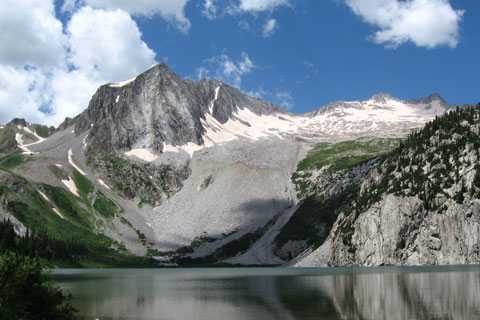| 648 | Trail Sense Hypothermia |
2012-05-22 |

Snowmass Lake, the next morning
Our bodies normal temperature range is between 98 and 100 degrees. Hypothermia occurs when the core body temperature drops below ninety-five degrees. As the core temperature drops below 98 degrees, the warning signs of hypothermia begin to occur.
In 2009, Amy and I were in Colorado climbing the Fourteeners. On almost every climb we tried new packing ideas. Our goal was to find what was the least amount of gear and weight we had to carry and still maintain a margin of safety. On several climbs we went too far...
Snowmass Mountain is usually climbed in two days with an overnight camp at Snowmass Lake. We had slept near the trailhead on the eve of the hike and had postponed doing many chores because we were so tired from climbing Capitol on the previous day. We awoke to rain. It was not raining hard, but was more like a drizzle. We were slow to pack and hit the trail.
The first few miles of the trail were relatively easy traveling. It was still raining, but the temperature was warm enough that we did not wear our rain gear. The decision on whether to wear rain gear or not was the choice of getting wet from the rain or getting wet from sweating while wearing the rain gear. We chose not to wear it.
After six easy miles we came to a small lake at about 10,000 feet. We crossed the outflow stream on a log jam, as the heavier rains began. The next two miles of trail to Snowmass Lake was much steeper. We therefore still did not put on rain gear. We knew we were hiking a strenuous section of the trail and were almost at the lake, so why stop? We both got cold, really cold. We finally stopped and put on our rain gear for the final climb to the lake, but even wearing rain gear, we could not warm our cores.
At the lake we quickly found a spot to camp and donned all of our dry clothes from our packs. After eating a bite, we tried to pitch the tent. It was a very difficult task, because our fingers were frozen and we had lost most of our dexterity.
As a weight saving, we had not packed a stove. As soon as possible, Amy jumped in the tent and ate one of her cold hamburgers she had bought in town the day before. Eating something usually warms us, but not this time. We had not packed enough food to eat and without a stove we did not have anything warm to eat or drink.
There used to be a slogan to raise awareness calling hypothermia - the silent killer. Well, there was nothing silent about our mild cases of hypothermia, our teeth were chattering so loudly that the woodpeckers were complaining.
After a few more hours of shivering, we finally regained our core temperatures. That evening was a struggle for us. We realized what was happening to our bodies and tried every trick we knew to reverse the loss. It eventually worked.
A few hypothermia prevention tips ...
There is a tipping point for carrying too little gear. You must be able to maintain a margin of safety.
Layer your clothing. Take the time to adapt the layering in order to keep your body warm and dry.
Slow down your pace so that you do not sweat.
If you plan to hike fast, then carry a dry shirt to change into if you get cold.
The minute you stop for a rest, put on an extra layer. Do not wait until you are chilled.
Always carry rain gear.
Keep your gear dry. Use pack covers and/or pack liners to keep dry gear dry.
Stoves like the JetBoil Ti Sol weigh so little, they can easily find a home in your pack.
Do exercises to increase warmth.
Eating helps raise your body's temperature.
Drinking hot fluids also helps and makes you feel better.
If you are really cold, then put on all your clothes, set up your tent, get in your sleeping bag, eat, drink, and do exercises.
Hypothermia can happen in any season.
A rainy, 50 degree day is prime hypothermia weather.
Everything is harder when you are hiking alone.
Happy dry and warm trails